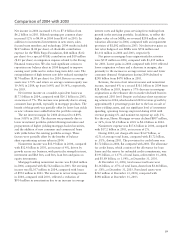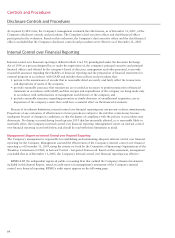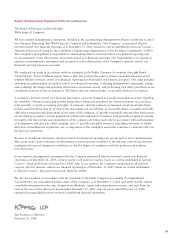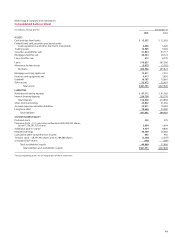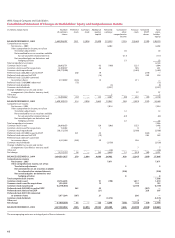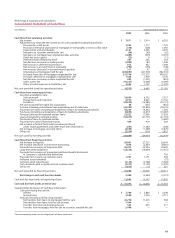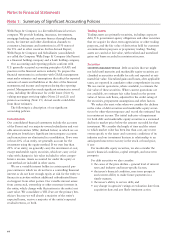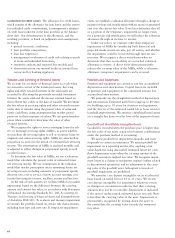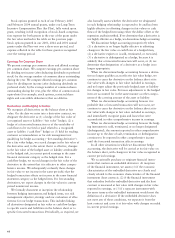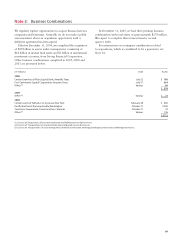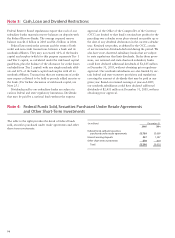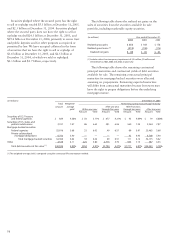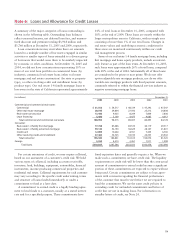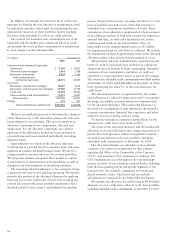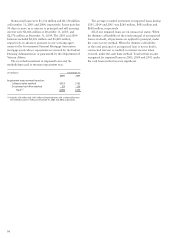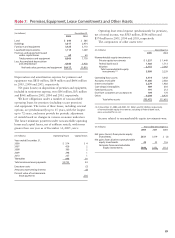Wells Fargo 2005 Annual Report Download - page 69
Download and view the complete annual report
Please find page 69 of the 2005 Wells Fargo annual report below. You can navigate through the pages in the report by either clicking on the pages listed below, or by using the keyword search tool below to find specific information within the annual report.
67
Operating Lease Assets
Operating lease rental income for leased assets, generally
automobiles, is recognized in other income on a straight-line
basis over the lease term. Related depreciation expense is
recorded on a straight-line basis over the life of the lease,
taking into account the estimated residual value of the leased
asset. On a periodic basis, leased assets are reviewed for
impairment. Impairment loss is recognized if the carrying
amount of leased assets exceeds fair value and is not recover-
able. The carrying amount of leased assets is not recoverable
if it exceeds the sum of the undiscounted cash flows expected
to result from the lease payments and the estimated residual
value upon the eventual disposition of the equipment. Auto
lease receivables are written off when 120 days past due.
Pension Accounting
We account for our defined benefit pension plans using an
actuarial model required by FAS 87, Employers’ Accounting
for Pensions. This model allocates pension costs over the
service period of employees in the plan. The underlying
principle is that employees render service ratably over this
period and, therefore, the income statement effects of
pensions should follow a similar pattern.
One of the principal components of the net periodic
pension calculation is the expected long-term rate of return on
plan assets. The use of an expected long-term rate of return
on plan assets may cause us to recognize pension income
returns that are greater or less than the actual returns of
plan assets in any given year.
The expected long-term rate of return is designed to
approximate the actual long-term rate of return over time
and is not expected to change significantly. Therefore, the
pattern of income/expense recognition should closely match
the stable pattern of services provided by our employees over
the life of our pension obligation. To determine if the expected
rate of return is reasonable, we consider such factors as
(1) the actual return earned on plan assets, (2) historical
rates of return on the various asset classes in the plan
portfolio, (3) projections of returns on various asset classes,
and (4) current/prospective capital market conditions and
economic forecasts. Differences in each year, if any, between
expected and actual returns are included in our unrecognized
net actuarial gain or loss amount. We generally amortize
any unrecognized net actuarial gain or loss in excess of a
5% corridor (as defined in FAS 87) in net periodic pension
calculations over the next five years.
We use a discount rate to determine the present value
of our future benefit obligations. The discount rate reflects
the rates available at the measurement date on long-term
high-quality fixed-income debt instruments and is reset
annually on the measurement date (November 30).
Income Taxes
We file a consolidated federal income tax return and, in
certain states, combined state tax returns.
We determine deferred income tax assets and liabilities
using the balance sheet method. Under this method, the net
deferred tax asset or liability is based on the tax effects of
the differences between the book and tax bases of assets and
liabilities, and recognizes enacted changes in tax rates and
laws. Deferred tax assets are recognized subject to manage-
ment judgment that realization is more likely than not.
Foreign taxes paid are generally applied as credits to reduce
federal income taxes payable.
Stock-Based Compensation
We have several stock-based employee compensation plans,
which are described more fully in Note 14. As permitted by
FAS 123, Accounting for Stock-Based Compensation, we have
elected to apply the intrinsic value method of Accounting
Principles Board Opinion 25, Accounting for Stock Issued to
Employees (APB 25), in accounting for stock-based employee
compensation plans through December 31, 2005. Pro forma
net income and earnings per common share information is
provided below, as if we accounted for employee stock
option plans under the fair value method of FAS 123.
On December 16, 2004, the FASB issued FAS 123
(revised 2004), Share-Based Payment (FAS 123R), which
replaced FAS 123 and superceded APB 25. We adopted FAS
123R on January 1, 2006, which requires us to measure the
cost of employee services received in exchange for an award
of equity instruments, such as stock options or restricted
stock, based on the fair value of the award on the grant
date. This cost must be recognized in the income statement
over the vesting period of the award.
(in millions, except per Year ended December 31,
share amounts) 2005 2004 2003
Net income, as reported $7,671 $7,014 $6,202
Add: Stock-based employee
compensation expense
included in reported net
income, net of tax 123
Less:Total stock-based
employee compensation
expense under the fair value
method for all awards,
net of tax (188) (275) (198)
Net income, pro forma $7,484 $6,741 $6,007
Earnings per common share
As reported $4.55 $ 4.15 $ 3.69
Pro forma 4.44 3.99 3.57
Diluted earnings per common share
As reported $4.50 $ 4.09 $ 3.65
Pro forma 4.38 3.93 3.53


